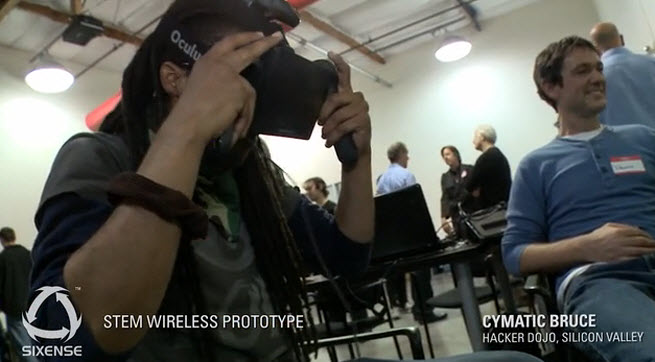Sixense Entertainment surpassed its goal for its Kickstarter crowdfunding campaign on Thursday, raising more than $402,3674 from 1,581 backers for a wireless version of its motion-sensing game controllers.
The startup, clearly benefiting from the rebounding popularity of virtual reality gaming, could wind up raising a lot more money during the remaining 29 days of its campaign. The success is a good indicator that motion-sensing and virtual reality are hot, and that gamers are hungry for something that goes beyond the next-generation consoles.
Amir Rubin, chief executive of Los Gatos, Calif.-based Sixense, gave GamesBeat an exclusive interview for a story that ran Wednesday. In that interview, he described Sixense’s motion-sensing technology as a great fit for the Oculus Rift. Ever since Oculus VR launched its developer version of Oculus VR, the Razer Hydras have been selling out. The Kickstarter campaign went live on Thursday, and the campaign surpassed its 30-day goal in a matter of hours.
On top of that, Sixense is creating its own branded product, the STEM System, for the wireless 3D controls. The STEM System consists of a base that contains a magnet that sends out pulses into a 3D space. The magnetic waves hit sensors and then bounce back to the base. The system calculates how long it took for the interaction and then figures out exactly where the object is in a 3D space. It works whether you have a line of sight or not, which makes it different from Microsoft’s Kinect motion-sensing system in that regard. The STEM System is also modular; you can put the motion sensors in a variety of places and positions.
Hardware makers will still be able to license designs from Sixense so they can embed it in their own products, as Sixense will support an open hardware and software development environment. Rubin encourages the community to create a wide variety of motion-sensing devices, such as swords, baseball bats, or head-mounted displays. The system works with Linux, Windows, and Mac.
The licensees can integrate the STEM technology into their products to make them Sixense compatible. Rubin foresees the STEM technology as the best way to navigate through a virtual reality world. The new system will have longer range of eight feet, wireless operation, modularity, and better tracking performance at all ranges. It also will be backward compatible with the library of games that support the Razer Hydra. And it supports up to five devices.
The wireless controller sensors can be placed on any part of your body to detect your motion. Rubin founded the company in 2007, but he has been working on motion-sensing technology for about two decades. Sixense has 18 employees, and it has raised $3 million to date.
Sixense has created its own game studio in San Francisco to create demos that make use of its technology. Sixense plans to ship a special edition of the STEM System to early adopters and developers as well as larger Kickstarter backers. Sixense hopes to ship production units in about a year.
VentureBeat's mission is to be a digital town square for technical decision-makers to gain knowledge about transformative enterprise technology and transact. Learn More


